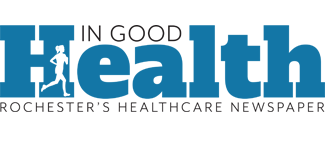You can take steps to reduce risks. It’s not that complicated, say experts
By Deborah Jeanne Sergeant
Age and genetics play part in your stroke risk. However, you can help mitigate even an elevated stroke risk with lifestyle modifications.
“We recommend that people eat a healthy diet, specifically focusing on following Mediterranean diet principles and avoiding ultra-processed foods,” said physician Adam Kelly, board member of the American Heart Association in Western New York and professor of neurology and director of teleneurology and regional development at University of Rochester Medical Center.
Ultra-processed, prepackaged foods typically contain elevated levels of sodium, which raises risk of high blood pressure, a stroke precursor. Check the nutrition facts on labels for a food’s sodium content.
Mediterranean style eating includes plenty of produce, cooking with olive oil instead of butter, whole grains instead of white and focusing on chicken, fish and other white meat instead of red meat. Reducing any alcohol intake to a modest level or better yet, abstaining helps reduce stroke risk.
Moving also matters.
“We encourage people to remain physically active, with a target of around 150 minutes of brisk activity per week,” Kelly said. “This does not need to be formal exercise at a gym; even activities around your home which get your heart rate up a little bit, such as yard work, can count towards this goal.”
Knowing your numbers can help keep track of your stroke risk. Blood pressure is key. Kelly said that even small increases in blood pressure for patients in their 30s and 40s can mean greater stroke risk later.
“Because of this, we encourage patients to have regular contact with their primary care provider or other medical professional including blood pressure checks and to have a low threshold to manage elevated blood pressures through medications or non-pharmacologic methods,” Kelly said.
Clots traveling through blood vessels to the brain cause strokes. Plaque inside blood vessels can cause clots when the plaque breaks free. Jonathan Donnelly, neurologist with Rochester Regional Health, said that risk factors for plaque include high cholesterol, high blood pressure (also called hypertension) and heart disease.
“High cholesterol in the low-density lipoprotein (LDL) is the kind that deposits along the walls of blood vessels,” Donnelly said. “It has a lot to do with diet, although that’s not the only factor. It can be genetic. A lot of the cholesterol in our bodies is made by our livers. Some are predisposed to high cholesterol. High LDL puts you at risk for that plaque to form and rupture.”
The aforementioned Mediterranean diet can help reduce cholesterol by up to 20%, which Donnelly said can help some people, but may not be enough to make a difference for older people, those who have had a stroke or heart attack or people with other risk factors. Prescribed medication can help.
Unmanaged Type 2 diabetes can also raise stroke risk, as it increases plaque in the blood vessels. Controlling Type 2 diabetes through proper diet and exercise, along with any prescribed medication can help reduce the patient’s stroke risk.
Smoking is also a risk factor.
“The chemicals in nicotine products drive inflammation, which can aggravate plaque and damage the blood vessels,” Donnelly said. “Stop smoking, which is obviously not an easy thing to do but we have nicotine reduction therapy and medication that can help.”
Originally touted as safer and even a means of cessation, vaping is neither of these.
“Vaping is still a relatively new thing and we’re already seeing it’s a risk for heart disease and stroke,” Donnelly said. “It’s not a safe alternative to smoking cigarettes.”
An undertreated risk factor he has also observed is obstructive sleep apnea, since it puts a lot of strain on the blood vessels. Fortunately, apnea is treatable once diagnosed.
Unmanaged stress can by extension raise stroke risk.
“People who have a lot of chronic stress, their resting heart rate may be higher and their blood pressure may creep up higher,” Donnelly said. “If you’re in that state all the time, eventually, your body will start to adjust and you’ll sit with a higher heart rate and blood pressure. It can interact with a lot of those things like heart disease and stroke risk. It’s not always modifiable unfortunately but it is treatable.”
Again, exercise can help reduce stress, along with other forms of self-care. Take time to engage in pleasurable activity daily, along with taking vacation time off from work.

